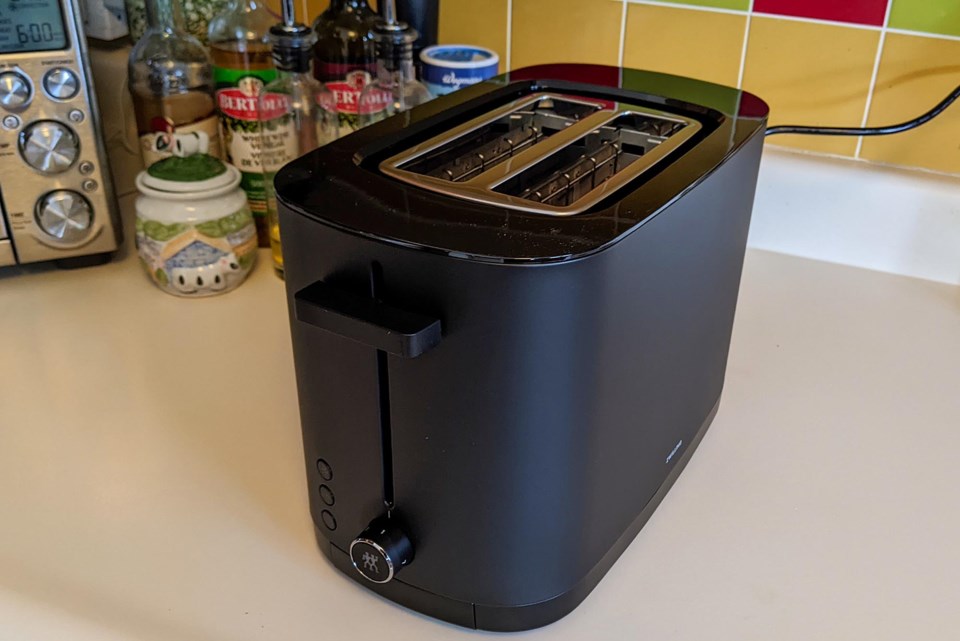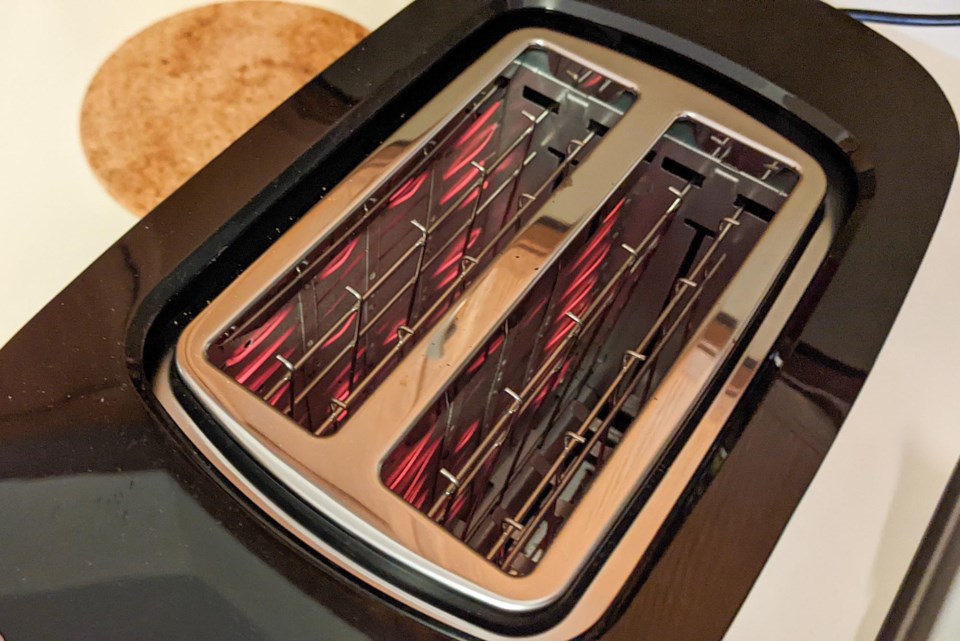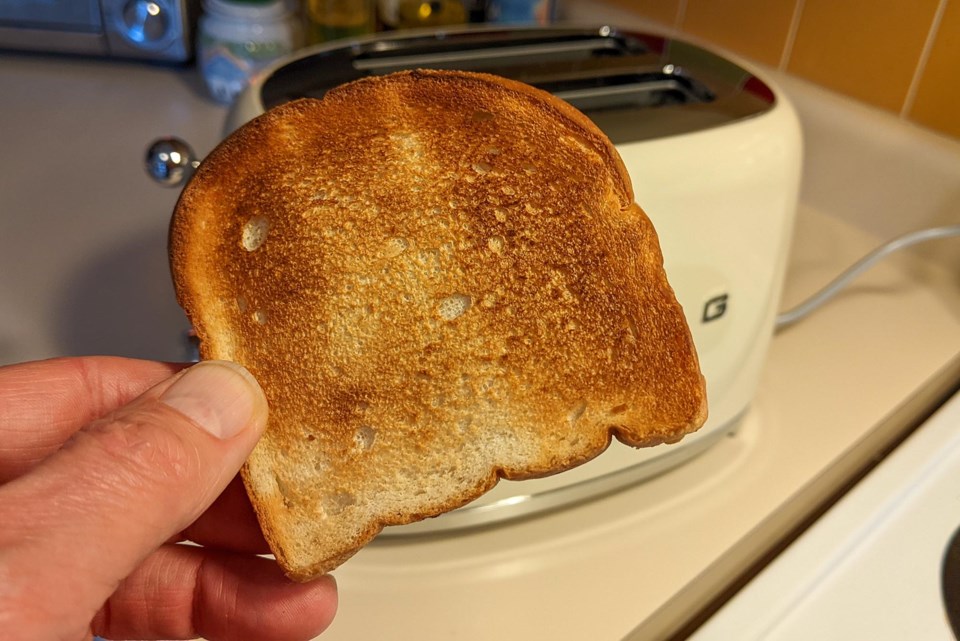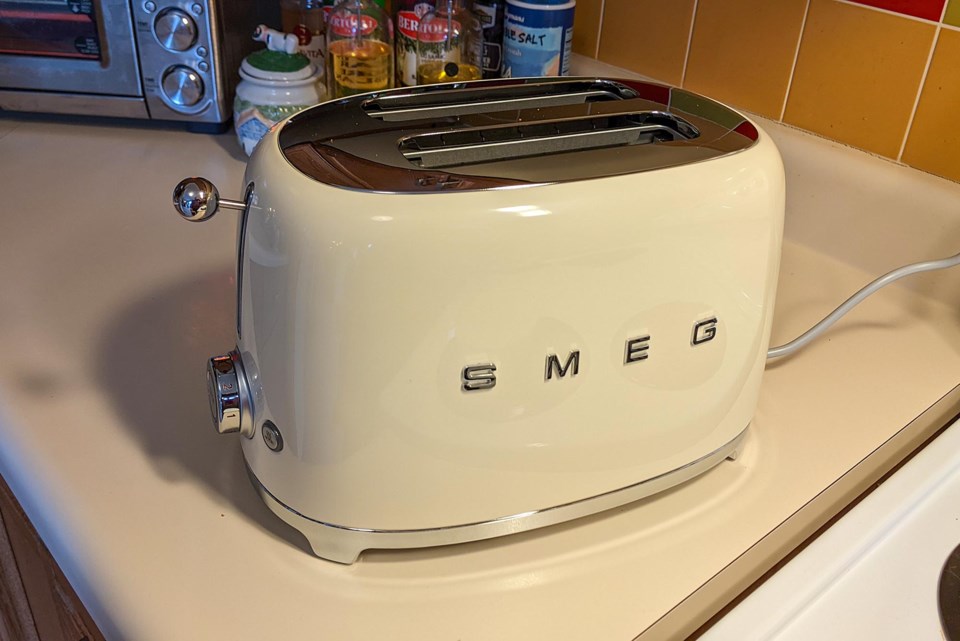Fourteen years ago we bought a Black & Decker two-slice toaster from Canadian Tire. At some point about five years ago I pushed the crumb tray back in at the wrong angle, leaving it forever wedged inside the bottom of the toaster. From then on to remove the crumbs we had to unplug the toaster, flip it upside down, and shake it over the sink.
Last week, in a year-end fit of housecleaning good intentions, I took it to the sink, flipped it over, and out cascaded approximately an entire loaf’s worth of blackened bits—a Mt. Everest of breadcrumbs and shrivelled raisins and fragments of carbonized cheese. I guess it had been awhile between shakes. It’s a wonder the thing hadn’t caught fire and put us on the What's That Siren list.
That’s it, said I. Time to fix the damned crumb tray.
In the comedy feature film version of this saga, this would be the opening scene, the action that gets the unexpected consequences ball rolling down the steep hill of unlikely coincidences and lucky accidents.
If it’s a rom-com, the boy gets the girl in the end thanks to a plucky customer service agent on the toaster manufacture’s toll-free help line. If it’s a black comedy, in the final scene the boy chokes to death on a piece of perfectly toasted bread from his newly repaired toaster.
Well, I’ve already got the girl, I’d prefer not to choke to death on even the most delicious toast, and in any case I’m not a boy. So let’s just call this genre a satire of modern appliances, with the hilarity coming from the bitterly comic failure of modern toaster manufacturers to manufacture a toaster that properly toasts.
But before we get to the rest of Act One, a slice of backstory: namely that appliances have been declining in quality and durability for decades. In recent years, manufacturers have also deliberately made it more difficult for consumers to do their own repairs. This encourages disposability, not longevity, an endless cycle of replacement rather than repair.
So it’s no wonder that a federal bill you probably haven’t heard of was introduced this autumn. It’s Bill C-244, An Act to amend the Copyright Act (diagnosis, maintenance and repair). It passed the Commons unanimously and had its first reading before the Senate in October.
In short, it would permit after-market sale of specialized tools to consumers so that they could repair their own appliances—tools that appliance manufacturers are increasingly making unique to their own brands. Forget trying to use a Phillips-head or even Torx screwdriver these days. Try a $200 wireless diagnostic tool that General Electric requires for certain appliances, plus a $720 yearly software subscription, according to reporting last week by the Toronto Star. (Quebec passed its own law this past summer banning the sale of products deliberately designed to become obsolete, and also requiring that they be repairable using standard tools.)
Now back to the conclusion of Act One, the Black & Decker debacle.
Determined to correct the errant crumb tray, I decided to take the toaster’s bottom off to get to it. Well, maybe even 14 years ago someone in the Black & Decker design department thought it would be nifty to prevent consumers from repairing their own toasters. Two of the four screws securing the bottom were good old Phillips-heads. But the other two were...unique. Since I'm in the habit of repairing our computer equipment, I have an absolute crapload of specialized tools to un-screw stuff. Nothing matched. These screws were total unknowns, and worse, they were located way down narrow plastic tunnels, making even seeing them difficult.
Screw it, so to speak. I’ll drill them out of the way.
Cue the slapstick montage!
Balance the toaster with one hand, aim the electric drill with the other, working on top of everyone’s favourite surface designed for humorous mishaps, a washing machine lid!
In the film version I would have drilled through a finger, spraying blood across the basement. In reality I bored right through the two holdouts and succeeded in loosening the toaster bottom. Then the black humour kicked back in when it became evident that even this didn’t allow access to the crumb tray, which had somehow become permanently incarcerated in its own cell, never to be paroled.
Worse, it was now impossible to put the toaster back together. An octopus wouldn’t have had enough arms to align all the mechanical parts at the same time in order to close it back up. Toaster now useless. Yes, it was toast.
Act Two: The Replacements
Black & Decker’s current version of the same model costs $21. That was the first red flag. I don’t remember what we paid 14 years ago, but I’m pretty sure it was at least double that.
Sure enough, at best this latest version weighed slightly more than the slices of bread put into it, slid around the counter at the merest breeze, ejected the toasted bread with enough force to pop it entirely out of the toaster, and, worst of all, toasted it hilariously unevenly—one side pleasingly caramel, the other side whiter than a Mississippi Klansman.
Back to Amazon it went. And then commenced a thorough reading of user reviews for the dozens of toasters available. Review after review of brand after brand cited the same issues—uneven toasting, and breakdowns at around a year. It turns out that you need to spend a few bucks these days to get a toaster that isn’t (a) a piece of useless crap right out of the box, or (b) turns into a piece of useless crap 12 months down the road.
Okay, let’s bump it up. Let’s spend $110 on a Zwilling model. This German company has been around for literally centuries. Since 1731. We have some of their excellent chef’s knives. Surely the Germans know how to design a simple toaster. (Yes, they are assembled in China, but so is everything, including the MacBook laptop I’m writing this on.)
But bear in mind that we’re now midway through Act Two, when expectations are turned on their head.
The next day the Zwilling arrived—all of this action, by the way, took place over just four days, since local Amazon fulfillment centres have apparently hired every single delivery driver in southern Ontario for the Christmas rush.

The Zwilling arrived. It was handsome—in an austere, Death Star sort of way. It did not slide around on the counter, it did not shoot toasted bread onto the countertop. It also did not toast very well.
Once again, suitably tanned on one side, MAGA Republican on the other. The problem was in the heating elements. Notice how some of them are dimmer than others:

Nearly 75 percent of Amazon buyers had given this model a five-star rating and excellent reviews. Maybe it was just this particular toaster, a bad day’s output at the factory in Shenzen. Let’s try another one of the same model. So back went the first Zwilling, and in comes the second Zwilling the following day.
We’re near the end of Act Two. Will there be a surprise twist with replacement toaster number three?
Only if you’re surprised to find out that the second Zwilling performed the same way as the first one, and even more so. Ebony and Ivory—an okay song but not the way you want your toast. Again, the heating elements failed to heat evenly. Back to Amazon went Zwilling number two.
Act Three, Christmas Eve day
So there we were, yesterday morning, a toastless Christmas on the horizon. Was it time to check out Canadian Tire? Would they have models that Amazon didn’t? (Basically no.)
A quick check of their website, which also confirmed that the store would be open until 3 PM. Still time for a miracle.
Why, what’s this. An Italian brand. Company is 75 years old. An appealing retro look, and 20 percent off, sale ending December 24! Only one drawback. It was $220 bloody bucks—and that was after the discount.
A quick comparison on Amazon of the same model: same price, but obviously no delivery until after Christmas.
Hey, we rarely splurge on anything, so why not make this a year-ending treat. Into the car I jumped, on Dancer on Vixen, and zipped over to the Welland store. In the parking lot there appeared a favourable sign from the heavens—by happenstance I parked opposite a large, familiar pickup truck, one covered in thin black cables.

Of course, the Joymaker truck! The father-son initiative, a pickup covered in a blanket of tiny Christmas lights, now in its fourth year, that raises funds for Pelham Cares. Bring us some toaster joy, Joymaker truck!
Cut to the final scene
The (old) boy still has the girl, he hasn’t choked on his toast, and finally we have a toaster that properly does what a toaster should—and always did, back before it took $220 to get one that (we fervently hope) will last for the next 14 years.

(Yes, the brand name—SMEG—is less than conducive to the appetite. If you don’t know why, count yourself fortunate.)
Merry Christmas and Happy Holidays to all. May your toast be ever evenly crisped, and your marmalade ever tangy.
See you in the New Year.


